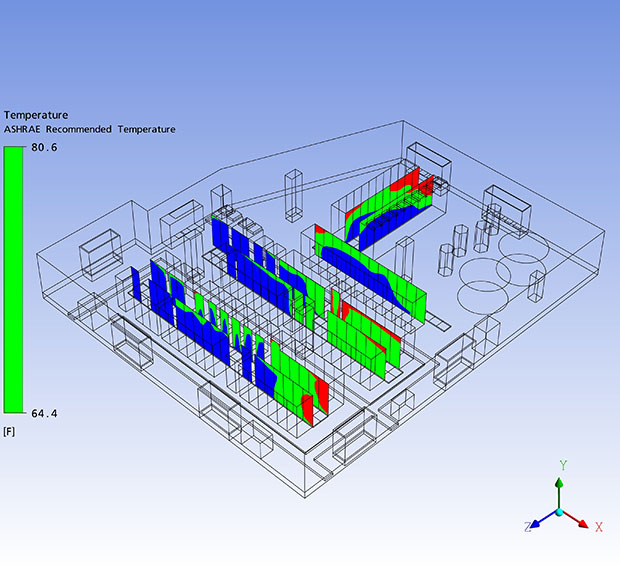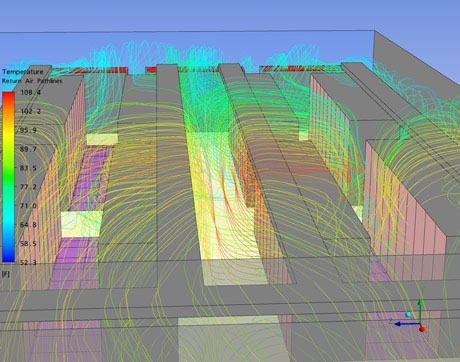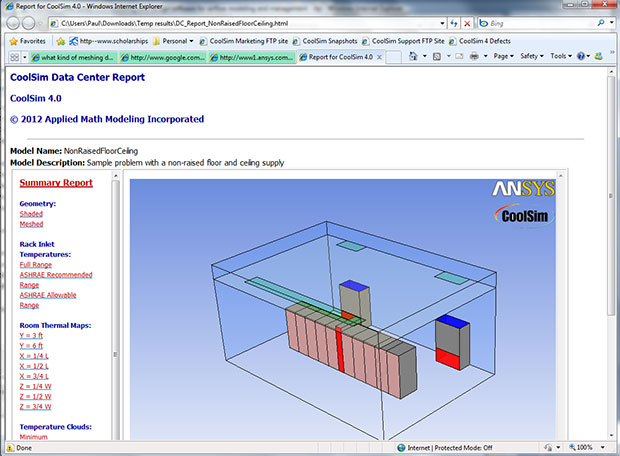
This CoolSim screen capture depicts server inlet temperatures with conformance to ASHRAE (American Society of Heating, Refrigerating and Air-Conditioning Engineers) recommendations. Image courtesy of Applied Math Modeling Inc.
Latest News
February 25, 2015
Applied Math Modeling Inc. has announced version 4.4 of its data center thermal modeling and design optimization software, CoolSim. According to the company, CoolSim 4.4, a cloud-based SaaS (Software-as-a-Service) solution, has been enhanced with features aimed at speeding up model building and simulation processes, allowing users to analyze more design alternatives prior to selecting the optimal design for a data center environment. The company adds that existing CoolSim users will find that version 4.4’s new features will speed up the modeling process, while new CoolSim users will find the learning curve to be minimal.
 CoolSim provides data center design engineers and operators a cloud- and subscription-based CFD (computational fluid dynamics) airflow modeling and design optimization tool. Image courtesy of Applied Math Modeling Inc.
CoolSim provides data center design engineers and operators a cloud- and subscription-based CFD (computational fluid dynamics) airflow modeling and design optimization tool. Image courtesy of Applied Math Modeling Inc.Applied Math Modeling reports that CoolSim 4.4 is based upon an all-new model-building environment that improves user productivity by allowing users to build models in multiple concurrent views. This, explains the company, enables users to construct a data center model using both 2D and 3D views simultaneously. Users also have the option to use multiple display monitors, which creates additional on-screen real estate for building more accurate representations of their data center.
Applied Math Modeling further explains that once users have a data center model built, CoolSim automatically submits it to a hosted HPC (high-performance computing) cluster for processing using ANSYS Fluent CFD (computational fluid dynamics) technology. Upon completion of the ANSYS Fluent simulation, users receive HTML output reports and 3D visual images. This methodology, says Applied Math Modeling, enables users to perform multiple what-if studies of your data center designs, which can help organizations determine the optimal placement of existing equipment, evaluate new or alternative designs, or visualize the effects of adding new equipment to your existing site.
 After users build their data center model, CoolSim automatically submits it to a hosted high-performance computing cluster for processing using ANSYS FLUENT CFD (computational fluid dynamics) technology. A data center results report produced by CoolSim is pictured. Image courtesy of Applied Math Modeling Inc.
After users build their data center model, CoolSim automatically submits it to a hosted high-performance computing cluster for processing using ANSYS FLUENT CFD (computational fluid dynamics) technology. A data center results report produced by CoolSim is pictured. Image courtesy of Applied Math Modeling Inc.Version 4.4. of CoolSim, says the company, now exposes parallel processing for faster turn-around times on large models, and users now have the ability to process multiple simulations concurrently for design optimization sequences. Additionally, users can import models from popular DCIM (data center infrastructure management) tools such as OpenDCIM from the openDCIM Foundation Inc.
Among the other new features in CoolSim 4.4 is a new Ducting Tool for the rapid addition and modeling of ducted supply designs, and the CoolSim library has been extended to allow users to store their user-defined objects and assemblies in addition to its collection of data center equipment, including CRAC (computer room air conditioning) units, tiles and racks from leading manufacturers and suppliers.
Improved features for ease of use include angle baffles, object alignment and transparency. Post-processing improvements cited by the company include higher fidelity output reports and 3D images. CoolSim 4.4 also sees improvements to overall solution robustness in the meshing and solver stages of processing, says the company.
 This CoolSim screen capture depicts server inlet temperatures with conformance to ASHRAE (American Society of Heating, Refrigerating and Air-Conditioning Engineers) recommendations. Image courtesy of Applied Math Modeling Inc.
This CoolSim screen capture depicts server inlet temperatures with conformance to ASHRAE (American Society of Heating, Refrigerating and Air-Conditioning Engineers) recommendations. Image courtesy of Applied Math Modeling Inc.“CoolSim 4.4 is the third major release in the past 12 months and represents another giant step in modeling capabilities,” said Paul Bemis, CEO of Applied Math Modeling, in a press statement. “Using CoolSim 4.4, users are now able to build complex data center models faster and with greater fidelity than ever before while leveraging the cost effectiveness of cloud computing to drive down simulation time and cost.”
CoolSim 4.4 requires a lightweight client application that is used to create the input information for the data center thermal model. Minimum system configuration includes a workstation running Windows 2000, XP, Vista or Windows 7; 256MB RAM (512MB recommended); 500MB of swap space; and a high-speed internet connection via wireless or LAN-based interconnect. Use of the client application is unlimited for both pre- and post-processing.
 This CoolSim screenshot shows the under floor pathlines of air velocity in a data center. Image courtesy of Applied Math Modeling Inc.
This CoolSim screenshot shows the under floor pathlines of air velocity in a data center. Image courtesy of Applied Math Modeling Inc.CoolSim is a subscription service that varies in price according to the expected use of the software. None of the CoolSim subscriptions are limited in terms of number of simulations, size of the data center, or quantity of data centers, according to the company. The subscription price includes full email and telephone support as well as access to the CoolSim User Portal and training modules. According to data on the Applied Math Modeling website, the entry price of a subscription for CoolSim starts at under $10,000, and subscriptions can be set for one month, multiple months or on an annual basis, depending on user needs.
For complete details on CoolSim 4.4, visit Applied Math Modeling.
Watch a video overview of CoolSim 4.4.
Download the CoolSim 4.0 brochure.
Access a library of data center design and analysis white papers.
Access a library of on-demand webinars on data center design and analysis.
Read more about how CoolSim works.
Request an evaluation of CoolSim 4.4.
See why DE‘s Editors selected CoolSim 4.4 as their Pick of the Week.
Sources: Press materials received from the company and additional information gleaned from the company’s website.
Subscribe to our FREE magazine, FREE email newsletters or both!
Latest News
About the Author
Anthony J. Lockwood is Digital Engineering’s founding editor. He is now retired. Contact him via [email protected].
Follow DERelated Topics






